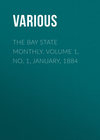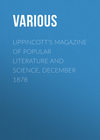Kitabı oku: «Notes and Queries, Number 179, April 2, 1853.», sayfa 3
Minor Queries with Answers
Sir John Thompson.—What are the crest, arms, motto, and supporters of Sir John Thompson, Bart., created Baron Haversham, of Haversham and Newport Pagnel, about the eighth year of William III.?
R. P. D.
[Or, on a fesse indented az. three etoiles ar.; on a canton of the second, a sun in his glory, ppr.—Crest, an arm, erect, vested gu. cuff ar. holding in the hand ppr. five ears of wheat or. Motto, "In lumine luce."—Robson's British Herald, vol. ii. s. v.; and for the plate, vol. iii. pl. 50.]
Ring, the Marriage.—When and how did the use of the ring, in the marriage ceremony, originate? Is it of Christian origin; or is it derived from the Jews, or from the Greeks or Romans?
Jonathan Pim.
[Brand quotes Vallancey and Leo Modena for the use of the marriage ring among the Jews (Popular Antiq., vol. ii. p. 103. edit. 1849). Wheatly, however, has given the most detailed account of its origin:—"The reason," he says, "why a ring was pitched upon for the pledge rather than anything else was, because anciently the ring was a seal, by which all orders were signed, and things of value secured (Gen. xxxviii. 18., Esther iii. 10. 12., 1 Maccab. vi. 15.); and therefore the delivery of it was a sign that the person to whom it was given was admitted into the highest friendship and trust (Gen. xli. 42.). For which reason it was adopted as a ceremony in marriage to denote that the wife, in consideration of her being espoused to the man, was admitted as a sharer in her husband's counsels, and a joint-partner in his honour and estate: and therefore we find that not only the ring, but the keys also were in former times delivered to her at the marriage. That the ring was in use among the old Romans, we have several undoubted testimonies (Juvenal, Sat. vi. ver. 26, 27.; Plin. Hist. Nat., lib. iii. c. i.; Tertull. Apol., c. vi. p. 7. A.). Pliny, indeed, tells us, that in his time the Romans used an iron ring without any jewel; but Tertullian hints, that in the former ages it was a ring of gold."—Rational Illustration of the Common Prayer, p. 390. edit. 1759.]
Amusive.—Is this word peculiar to Thomson, or is it made use of by other poets? Its meaning does not appear to be very definite. In the Spring it is applied to the rooks, with their "ceaseless caws amusive;" in the Summer to the thistledown, which "amusive floats;" and in the Autumn, the theory of the supposed cause of mountain springs is called an "amusive dream." Thomson seems to have been partial to these kind of adjectives, "effusive," "diffusive," "prelusive," &c.
Cuthbert Bede, B.A.
[A reference to Richardson's Dictionary will show that, however fond Thomson may have been of this word, it is not one peculiar to him. Whitehead says:
"To me 'twas given to wake th' amusive reed,"
and Chandler, in his Travels in Greece, speaks of the wind "murmuring amusively among the pines."]
Belfry Towers separate from the Body of the Church.—At Mylor, near Falmouth, there is an old tower for the bells (where they are rung every Sunday), separate from the church itself, which has a very low tower. Are there many other instances of this? I do not remember to have seen any.
J. S. A.
[If our correspondent will refer to the last edition of the Glossary of Architecture, s. v. Campanile, he will learn that though bell towers are generally attached to the church, they are sometimes unconnected with it, as at Chichester cathedral, and are sometimes united merely by a covered passage, as at Lapworth, Warwickshire. There are several examples of detached bell-towers still remaining, as at Evesham, Worcestershire; Berkeley, Gloucestershire; Walton, Norfolk; Ledbury, Herefordshire; and a very curious one entirely of timber, with the frame for the bells springing from the ground, at Pembridge, Herefordshire. At Salisbury a fine early English detached campanile, 200 feet in height, surmounted by a timber turret and spire, stood near the north-west corner of the cathedral, but was destroyed by Wyatt.]
An Easter-day Sun.—In that verse of Sir John Suckling's famous Ballad upon a Wedding, wherein occurs the simile of the "little mice," what is the meaning of the allusion to the Easter-day sun?—
"But oh! she dances such a way,
No sun upon an Easter-day
Is half so fine a sight!"
Cuthbert Bede, B.A.
[It was formerly a common belief that the sun danced on Easter-day: see Brand's Popular Antiquities, vol. i. p. 161. et seq. So general was it, that Sir Thomas Browne treats on it in his Vulgar Errors, vol. ii. p. 87. ed. Bohn.]
Replies
HAMILTON QUERIES
(Vol. vii., p. 285.)
On reference to the Peerages of Sir Harris Nicolas and Wood, I feel no doubt that the father of Lord Spencer Hamilton, as Tee Bee remarks, was the fifth Duke of Hamilton, and not the third, as Collins (edition Brydges) states, who misled me. Perhaps the perplexity, if any, arose from Anne Duchess of Hamilton, the inheritress of the ducal honours by virtue of the patent of 1643, after the deaths of her father and uncle s. p. m., having obtained a life dukedom for her husband, William Earl of Selkirk, and, subsequently to his decease, having surrendered all her titles in favour of their eldest son, James Earl of Arran, who was in 1698 made Duke of Hamilton, with the same precedency of the original creation of 1643, as if he had succeeded thereto.
Sir William Hamilton, the ambassador, married first, Jan. 25, 1752, the only child of Hugh Barlow, Esq., of Lawrenny in Pembrokeshire, with whom he got a large estate: she died at Naples, Aug. 25, 1782, and was buried in Wales. His second lady was Emma Harte, a native of Hawarden in Flintshire; where her brother, then a bricklayer working for the late Sir Stephen Glynne, was pointed out to me forty years ago. In Wood's Peerage it is stated that Sir W. Hamilton's second marriage took place at London, Sept. 6, 1794: he died in April, 1803, and was buried in Slebech Church.
I well remember Single-speech Hamilton, who was a fried of the family, dining with my father when I was a little boy; and I still retain the impression of his having been a tall and thin old gentleman, very much out of health. He left a treatise called Parliamentary Logick, published in 1808. The brief memoir of the author prefixed to the work, makes no mention of him as a member of the House of Hamilton; but it is said that he derived his name of Gerard from his god-mother Elizabeth, daughter of Digby, Lord Gerard of Bromley, widow of James, fourth Duke of Hamilton, who fell in the duel with Lord Mohun, which looks as if some affinity was recognised. The same authority tells us that William Gerard Hamilton was the only child of a Scotch advocate, William Hamilton, by Hannah Hay, one of the sisters of David Bruce, the Abyssinian traveller; and that he removed to London, and practised with some reputation at the English bar. Mr. W. G. Hamilton died, unmarried, in July, 1796, æt. sixty-eight.
Braybrooke.
Tee Bee has, by his Queries about Sir W. Hamilton, recalled some most painful reminiscences connected with our great naval hero. According to the statement in the New General Biographical Dictionary, Sir William Hamilton was married to his first wife in the year 1755; but although it is asserted that she brought her husband 5000l. a-year, her name is not given. She died in 1782, and in 1791 "he married Emma Harte, the fascinating, mischievous, and worthless Lady Hamilton." Pettigrew, in his Memoirs of Nelson, says, that this marriage took place at St. George's, Hanover Square, on the 6th of September, 1791. Tee Bee will find a full account of Lady H. in the above-mentioned work of Pettigrew.
F. S. B.
THE WOOD OF THE CROSS
(Vol. vii., p. 177.)
I never heard of our Lord's cross having been made of elder wood. The common idea, legend, or tradition, that prevailed formerly was, that the upright beam of the cross was made of cedar, the cross-beam of cypress, the piece on which the inscription was written of olive, and the piece for the feet of palm.
The legend concerning the wood of the cross is very curious, and may be analysed as follows:—When Adam fell sick, he sent his son Seth to the gate of the garden of Eden to beg of the angel some drops of the oil of mercy that distilled from the tree of life. The angel replied that none could receive this favour till five thousand years had passed away. He gave him, however, a cutting from the tree, and it was planted upon Adam's grave. It grew into a tree with three branches. The rod of Moses was afterwards cut from this tree. Solomon had it cut down to make of it a pillar for his palace. The Queen of Sheba, when she went to visit Solomon, would not pass by it, as she said it would one day cause the destruction of the Jews. Solomon then ordered it to be removed and buried. The spot where it was buried was afterwards dug for the pool of Bethsaida, and the mysterious tree communicated the power of healing to the waters. As the time of the Passion of Christ approached, the wood floated on the surface of the water, and was taken for the upright beam of the cross. See this curious legend at greater length in the Gospel of Nicodemus; the Legenda Aurea at the feasts of the Discovery and Exaltation of the Cross; Curzon's Monasteries of the Levant, p. 163.; and Didron's Iconography, p. 367., Bohn's edition.
I think, however, that I can explain the origin of the question put to Rubi by his poor parishioner as to the cross having been made of elder wood. His question may have sprung from a corruption of an old tradition or legend regarding not our Saviour, but Judas his betrayer. Judas is said to have hanged himself on an elder tree. Sir John Maundeville, in his description of Jerusalem, after speaking of the Pool of Siloe, adds,
"And fast by is still the elder tree on which Judas hanged himself for despair, when he sold and betrayed our Lord."—P. 175., Bohn's edit.
To return to the wood of the cross. In Sir John Maundeville's time a spot was pointed out at Jerusalem as the spot where the tree grew:
"To the west of Jerusalem is a fair church, where the tree of the cross grew."—P. 175.
and he speaks of the wood of this tree as having once been used as a bridge over the brook Cedron (p. 176.). Henry Maundrell describes a Greek convent that he visited, about half an hour's distance from Jerusalem:
"That which most deserves to be noted in it, is the reason of its name and foundation. It is because there is the earth that nourished the root, that bore the tree, that yielded the timber, that made the cross. Under the high altar you are shown a hole in the ground where the stump of the tree stood."—P. 462.
These are some of the legendary traditions regarding the history and site of the wood of the cross, up to the time of the Passion of Christ.
Ceyrep.
EDMUND CHALONER
(Vol. vi., p. 292.)
I have been waiting for several months in expectation of seeing some satisfactory reply to Ursula's Query. It seems, however, that, in common with myself, your numerous correspondents are quite at a nonplus. Wood, in his Athenæ Oxoniensis, vol. ii. p. 163., mentions this Edmund Chaloner as being about nineteen (Ursula says twenty-one) years old at the death of his father, James Chaloner, in 1660. Wood, Granger, as also Burke in his Extinct Baronetage, represent James as being the fourth son of Sir Thomas Chaloner of Gisborough, in the county of York, and this appears to be the general impression as to his parentage. In a History of Cheshire, however, written, I believe, by Cowdray, and published in 1791, the author claims him as a native of that county, and makes him to be of much humbler birth and descent than any of his other biographers. Hear him in his own words:
"Our succeeding (Cheshire) collectors form a family harmonic trio, a father, son, and grandson, of the surname of Chaloner, and of the several Christian names, Thomas, Jacob, and James. Thomas was an arms-painter in Chester about 1594; he knew the value of learning sufficiently to give his son a better education than he received himself. And this son followed the same occupation in Chester, and made collections, about the year 1620. But it was James, the grandson, who reflected the greatest credit upon his family, by a very concise, accurate, and sensible account of the Isle of Man, printed at the end of King's Vale Royal, in 1656. He laid the foundation of a learned education in our much honoured college (Brazennoze); and when the parliament invested Lord Fairfax with the Seignory of Man, he was one of his lordship's three commissioners for settling the affairs of that island. The antiquarian collections of all the three Chaloners are valuable."
Without specially binding myself to either one of these conflicting testimonies, I may be allowed to suggest that, apart from any proof to the contrary, the inference that he was a native of Chester is a perfectly fair and legitimate one. His Short Treatise of the Isle of Man, which was the only work he ever sent to press, was printed at the end of that famous Cheshire work, the Vale Royal of England, in 1656, and was illustrated with engravings by Daniel King, the editor of that work, himself a Cheshire man. Independent of this, his biographer Wood informs us that he was "a singular lover of antiquities," and that he "made collections of arms, monuments, &c., in Staffordshire, Salop, and Chester," the which collections are now, I believe, in the British Museum. He made no collections for Yorkshire, nor yet for London, where he is stated by Wood to have been born. One thing is certain, James Chaloner of Chester was living at the time this treatise was written, and was, moreover, a famous antiquary, and a collector for this, his native county; but whether he was, de facto, the regicide, or merely his cotemporary, I leave it to older and wiser heads to determine.
T. Hughes.
Chester.
*[In the Harleian Collection, No. 1927., will be found "A paper Book in 8vo., wherein are contained, Poems, Impreses, and other Collections in Prose and Verse; written by Thomas Chaloner and Randle Holme, senior, both Armes-Painters in Chester, with other Notes of less value."—Ed.]
"ANYWHEN" AND "SELDOM-WHEN:" UNOBSERVED INSTANCES OF SHAKSPEARE'S USE OF THE LATTER
(Vol. vii., p. 38.)
Mr. Fraser's remark about the word anywhen has brought to my mind two passages in Shakspeare which have been always hitherto rendered obscure by wrong printing and wrong pointing. The first occurs in Measure for Measure, Act IV. Sc. 2., where the Duke says:
"This is a gentle provost: seldom-when
The steeled gaoler is the friend of men."
Here the compound word, signifying rarely, not often, has been always printed as two words; and Mr. Collier, following others, has even placed a comma between seldom and when.
The other passage occurs in the Second Part of King Henry IV., Act IV. Sc. 4.; where Worcester endeavours to persuade the king that Prince Henry will leave his wild courses. King Henry replies:
"'Tis seldom-when the bee doth leave her comb
In the dead carrion."
Here also the editors have always printed it as two words; and, as before, Mr. Collier here repeats the comma.
That the word was current with our ancestors, is certain; and I have no doubt that other instances of it may be found. We have a similar compound in Chaucer's Knight's Tale, v. 7958.:
"I me rejoyced of my lyberté,
That selden-tyme is founde in mariage."
Palsgrave, too, in his Eclaircissement de la Langue Françoise, 1530, has—
"Seldom-what, Gueres souvent."
Seldom-when, as far as my experience goes, seems to have passed out of use where archaisms still linger; but anywhen may be heard any day and every day in Surrey and Sussex. Those who would learn the rationale of these words will do well to consult Dr. Richardson's most excellent Dictionary, under the words An, Any, When, and Seldom.
This is at least a step towards Mr. Fraser's wish of seeing anywhen legitimatised; for what superior claim had seldom-when to be enshrined and immortalised in the pages of the poet of the world?
S. W. Singer.
Manor Place, South Lambeth.










